I’ve done enough complaining about food in Seville that you probably know it is kind of bad. Honestly I was beginning to lose hope that good food existed in Spain (or nearby). I had my sights set on future trips to Italy, Greece, Copenhagen, lands of fresh pasta and bread and delicate pastries.
And then I went to the north-east of Spain and Portugal (also basically the north east of Spain geographically). And everything changed. Below is a (long) exploration of the things I ate in Galicia and Porto that reminded me that restaurants are not dead and categories of food outside 1) fried and 2) potato.
Galicia
Coming to Galicia after spending nearly all of your time in Seville is like going to Maine after living your whole life in Texas. A one hour flight brought us from dry heat, narrow windy streets, and jamon to lush forests, running rivers, and lots of seafood.
Galicia is an autonomous community that was originally inhabited by a Celtic tribe, and is about as far north as you can get in Spain — most residents, though, speak Galego, a weird Portuguese-Spanish hybrid. So actually being in Galicia is like being in Maine if everyone spoke with a thick New York accent and there were, like, palm trees everywhere.
We were there to visit our friend Susana and did do a fair amount of cooking together, which reminded me a little bit of being back in our college house, everyone assembling random meals and sitting on the floor at our low coffee table. Our meals included:
a park picnic of a hunk of baguette, oranges, carrots, and hummus and purchased Susana’s favorite focaccia and a veggie empanada galega (basically a very large empanada that you cut into squares)
two breakfasts, one with a perfect glistening mango, fresh bakery bread with avocado and scrambled eggs (and red pesto! a newfound staple) and tea and coffee to ward off the morning chill
pesto pasta with mushrooms and a bag of frozen vegetables, assembled very late at night after very many glasses of wine (and everything tastes insanely delicious very late at night after lots of wine)
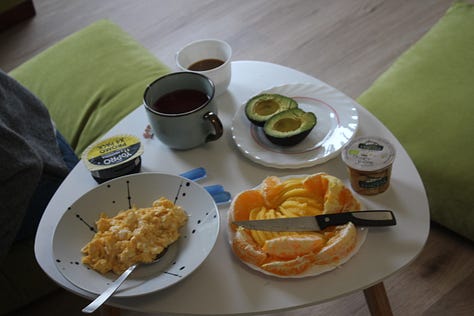


food styling skills could use some work
Galicia, like Seville, is a lot of crazy winding streets connected by passageways between buildings (we live in a passage in Seville, which offers a nice respite from the hustle of the two commercial streets that run parallel to our apartment). In one passageway, aptly named Ruela de Entrerruas (‘street between streets’) we met up with friends for dinner at NARA, a Korean tapas place.
We sat outside at a tiny table, wrapped in our coats and scarves, and talked about our favorite bodies of water as we perused the menu. We ordered a bunch to share, shocker: kimchi focaccia (!), a shrimp pad thai, and noodles with tuna. The focaccia was insanely springy with a nicely caramelized top and I will be attempting to recreate it at home. Both noodle dishes were quite different but had a lot of flavor — the shrimp especially was spicy and peanuty and had a nice fresh addition of some mint. I had been sorely missing a good noodle dish (ie the hand-pulled noodles from Peter Chang in Short Pump and anything from Monsoon Thai in Charlottesville) and these scratched that itch!
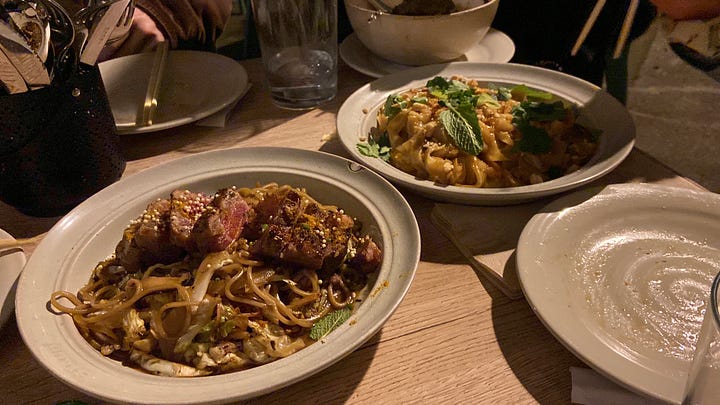

The main event of the trip, though, was the two lunches we had with Sus (if you watched My Octopus Teacher and felt incredibly touched/changed, don’t scroll any further)
In a little beach town called Porto de Son where Susana teaches, we worked up an appetite digging in tide pools and wandering past boats and the tiniest dog I’ve ever seen. Lunch was at a place Susana had been before with her dad — she did not lead us astray with her ordering, and we ended up with scallops, a salad, and octopus.
Our second lunch was at the market below Susana’s apartment, in a restaurant that sources its ingredients from the vendors. We ordered more octopus, razor clams, a vegetable crepe with goat cheese, and cream-filled crepes for dessert.
My previous experiences with octopus had been limited to calamari at chain restaurants that I suspect was probably frozen/thawed/flash fried. This octopus though…. this octopus changed my life. We had one pulpo a feira, a typical Galician preparation where the octopus is boiled, cut into rounds, and covered with olive oil, paprika and salt. This sounds deceptively simple but let me tell you, it was incredible. The texture was perfect, chewy without being rubbery, and each piece was a little smoky, a little salty, a little fatty, just perfect.
The second octopus dish, polbo á grella, was basically an entire head grilled and covered with a similar blend of seasonings, served atop a buttery mashed potato puree. I probably could’ve eaten the entire thing myself — tender and chewy and then a little crispy and charred at the ends.

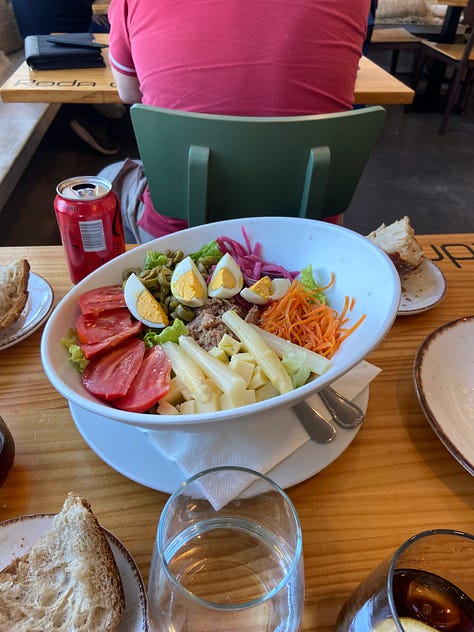
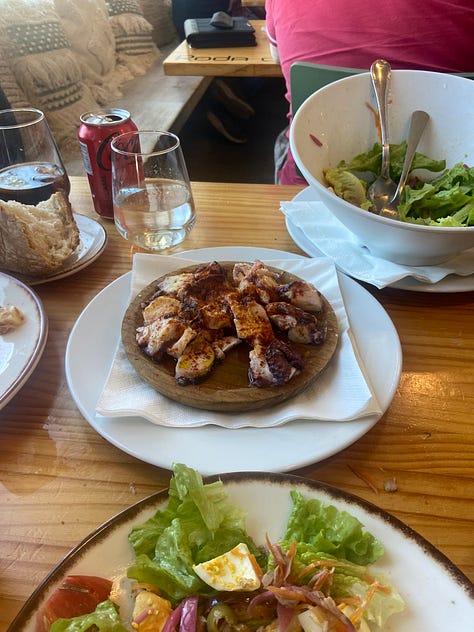
The razor clams and scallops were also really unlike anything I’ve had before — the clams a little briny but covered in enough oil and lemon to be balanced, the scallops swimming in butter. The crepe with goat cheese was an unexpected star, salty and savory and basically collapsing into rivers of melty cheese and sauteed veggies by the end.



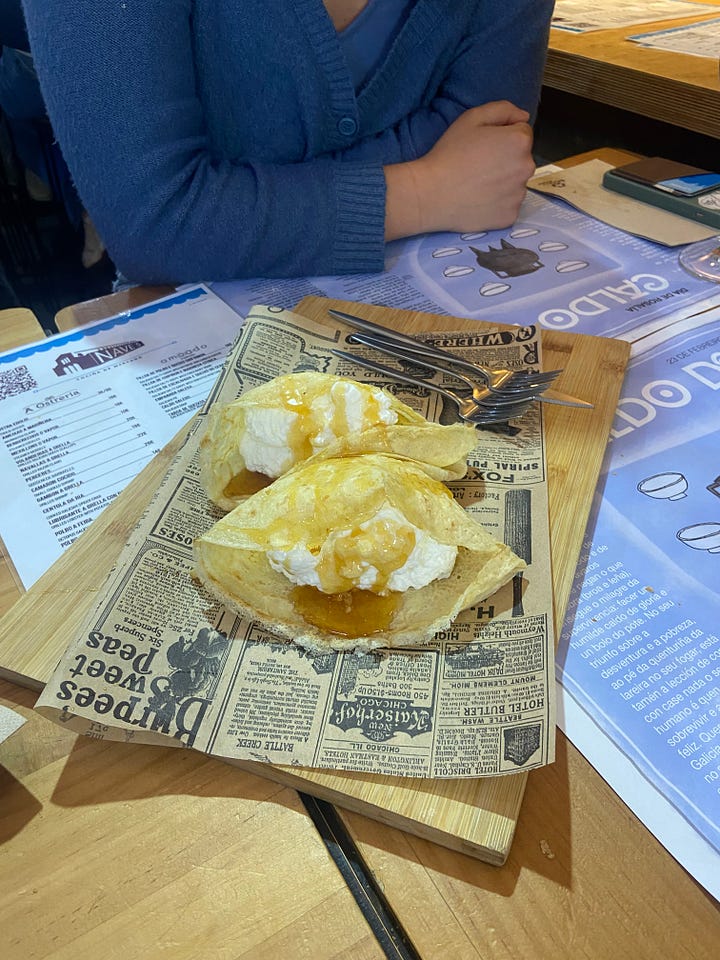
We were kept in good company with good food and lots of bread and fruit, a tarta de Santiago from a very nice nun in a church who accepted credit cards, and even an empanada for the road — what more could you want?
Portugal
We stayed in Porto for three days before we headed south for a Workaway. We spent our time exploring (two huge food markets, a photography museum in an old prison, sitting by the river, looking at pigeons) and eating a lot of snacks, notably one of Portugal’s most famous little treats — the pasteis de nata, or custard tart. The outer crust is crisp and flaky and not super sweet, and the custard inside is decadent and usually caramelized on top. They’re usually served with cinnamon and/or powdered sugar, and they remind me of my mom’s French toast — a little eggy and sweet and spiced. After all the ones we tried, I’ve decided I prefer a nice crisp crust and a more set custard (we had one warm from the oven but the inside was a little too runny for my taste) with lots of browning and also lots of cinnamon.
We ate like six of these. We also had some brigadeiro, which is technically a Brazilian dessert but which I had to track down in Portugal because my au pairs used to make them for us all the time for school parties. Brigadeiro is a very simple combination of sweetened condensed milk, cocoa powder, and butter cooked til its almost caramel-y, then cooled, rolled into balls, and coated in sprinkles (or jimmies, as my mom calls them). They’re like fudge and caramel and brownies all rolled (hehe) into one and I could eat probably sixty.
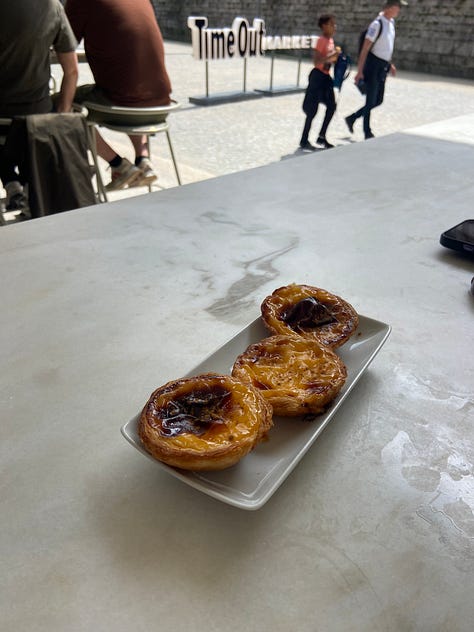

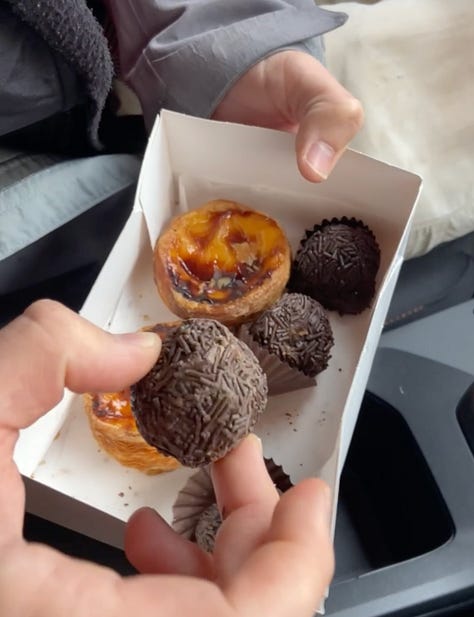
We also tried bifana, a popular street food sandwich made with thin slices of marinated pork on a heated roll. The meat was surprisingly flavorful and a little spicy thanks to the piri-piri sauce, and the bread soaked up alllll that juice for a really satisfying little snack. Stopping at a tiny cafe between Porto and Pinheiro de Bemposta, where we were headed for our Workaway, we hoped to try codfish croquettes, which are apparently another popular fried snack. The cafe owners were very confused about our request and kept asking why we weren’t eating LUNCH. We just want the fritters, we said, so they sat us down and served us… lunch. This included two of the codfish fritters, a rissois which is basically a meat pastry, sides of rice and potatoes, a large hunk of bread, and an unassuming vegetable soup with cabbage and garbanzos. Literally three courses.
I’ve been burying the lede a little bit, which is that I also had probably one of the best meals of my life in Porto. Writing this right now is making me feel genuinely a little depressed that I might never go back. Like actually I would book a ticket to Porto just to eat there again.
So: we were recommended this restaurant by a friend and walked in the first night without a reservation. We were greeted by a rather harried looking waiter who told us he was absolutely booked — they were short-staffed that night and couldn’t accommodate walk-ins. I made a reservation for Sunday and we decided to try to walk in on Saturday, too. The same waiter greeted us Saturday when we walked in two minutes after they opened and we sheepishly explained we were hoping to snag a table even without a reservation. He seemed pleased we had returned and was able to oblige.
Taberna Folias de Baco specializes in natural wines and a small, seasonal menu. We decided against their fixed menu for two (there were three of us Saturday) and ordered a la carte with help from our waiter, who introduced himself as Andre. Andre, another man, and a woman with awesome micro bangs run the whole restaurant themselves.
First up was wine. Andre asked for our preferences (white, nothing too sweet for me) and brought us each a bottle to taste. Mine was almost salty, bright and balanced. It accompanied an octopus salad with black beans, red onion, parsley, and a light, acidic dressing.
It was at this point we knew we were in for a treat. That salad… it was so interesting and texturally varied and SO delicious — salty, the perfect amount of vinegar and fresh herb, chewiness from the octopus, a crunch from the other veggies. If a salad can be described as decadent, that one was. Next up came four dates wrapped with a cured pork and stuffed with cheese, served atop a little bed of corn nuts. Anyone who has ever had a bacon-wrapped date knows they are epic. The bacon was crisp, the date was soft and warm and caramel-y, the cheese was salty… the perfect bite. We were weirded out by the corn nuts but they were an awesome addition.
Portugal is also famous for a type of sausage called alheira, a blend of bread, garlic, and other types of meat like chicken, pork, or game meats. We ordered a version here with pork and chicken, and it was perfect — so hot the skin crackled, chewy and dense and smokey. The second man came over from the kitchen to serve it, and shyly asked if we were interested in a “spicy sauce” to accompany it. We were. It was so good we asked how he made it — a blend of spicy pepper, garlic, and cinnamon and clove (!).
Our final round was three different toasts: a green olive and fig tapenade with vegan creme fraiche and dill, mushrooms on a pumpkin puree with cheese and almonds, and smoked mackerel on a white bean yogurt puree. Each was served on a thick slice of rye bread and it was almost impossible to decide on a favorite. I am actually having trouble describing how well all the flavors worked together — there was not a single thing that felt out of place. Literally every element added something unique. These are the Hermes of toasts.
Of course after all that we also had to order dessert, a black sesame pudding that tasted like the richest peanut butter mousse you’ve ever had, deep and almost earthy with a sprinkling of sesame seeds on top. It changed my life.
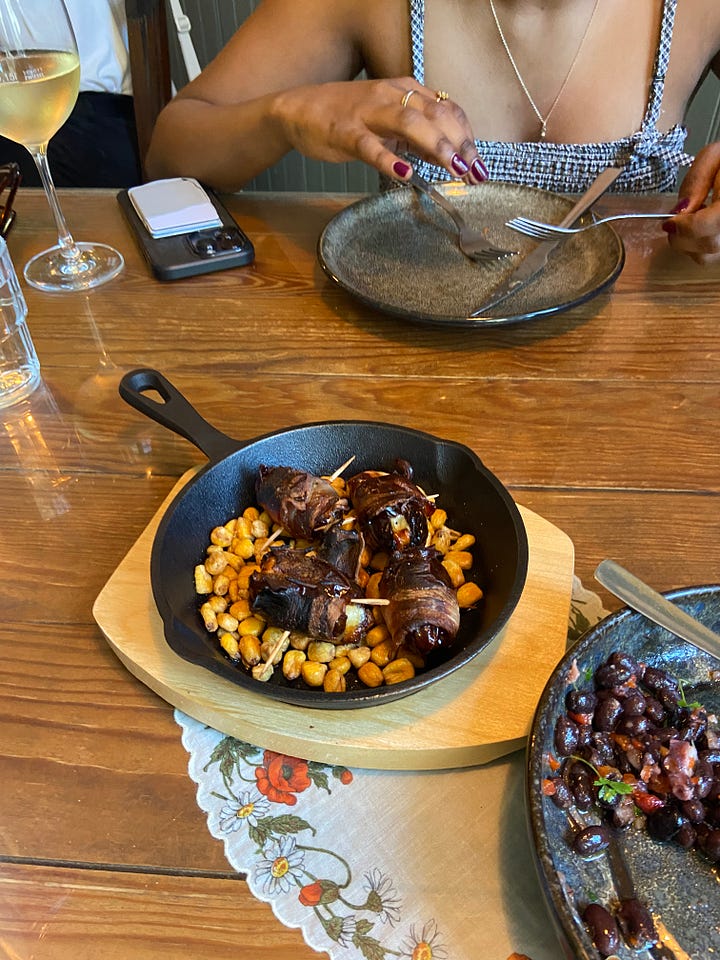
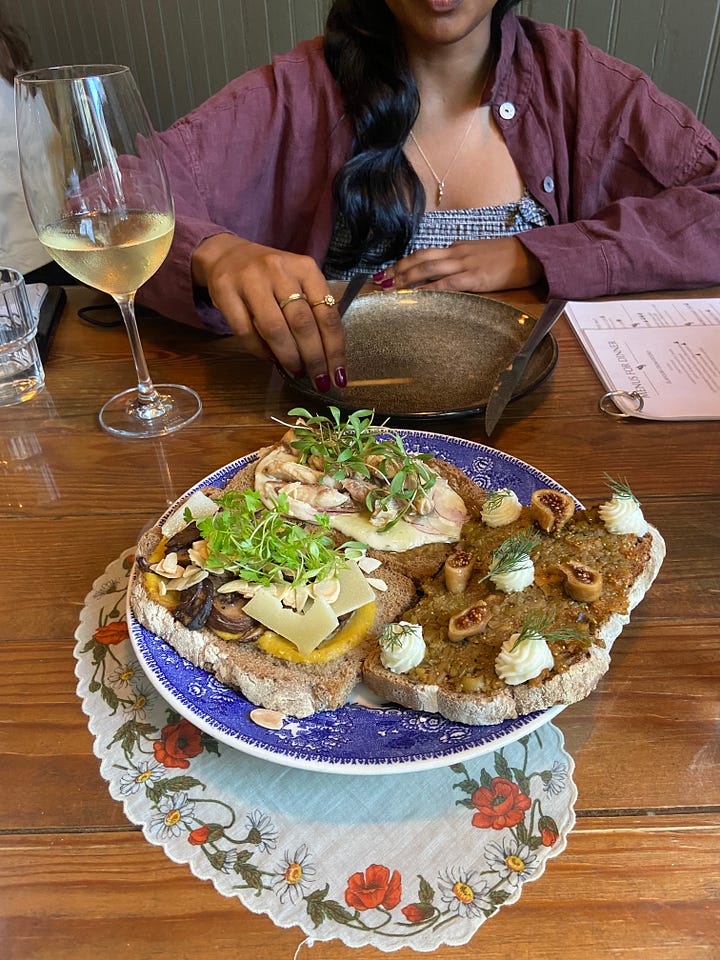

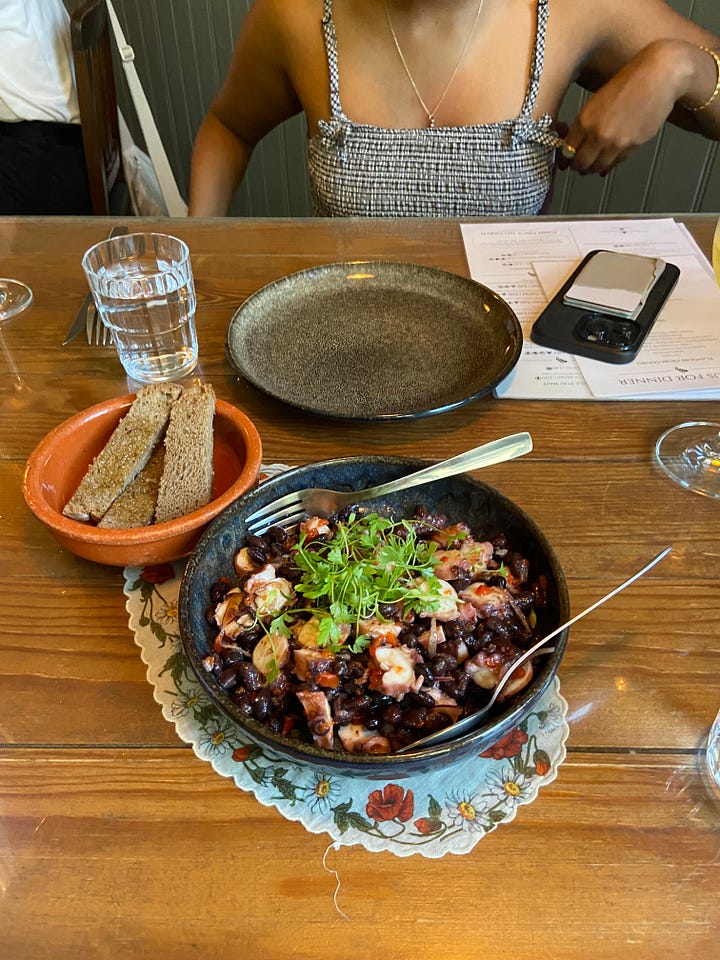
The original plan had been to cancel the Sunday reservation if we made it in on Saturday. We did not, in fact, stick to the original plan.
The second time around, Philip and I tried the codfish salad and conquered the final remaining toast we had not sampled, this one with salami, a chestnut puree, and an incredible coffee (!) syrup on top. We also ordered savory vegan muffins and prosciutto empanadas, the other menu items we had been intrigued by and not ordered (Andre directed us away from trying black sausage, which he said he “does not prefer”).
The salad! Salty and crunchy! I liked the octopus a little more because of the bean ratio (high) but this was also delightful. The salami toast was insane mostly because of that coffee drizzle (I am telling you these people are CRAZY inventive). My toast ranking was:
Salami (the salty x sweet combo is always winning for me)
Fig (salty! sweet! creme fraiche!)
Mackerel (that smoky fish with the bean… yum)
Mushroom (literally also amazing. just not as amazing.)
The muffins were vegan (!) and tasted winter-veggie forward (mushrooms, carrots). Our friend from before brought spicy sauce for us (“no sausage this time but do you want?”) which really elevated them. They were probably my least favorite thing we ate and I would still eat like six of them.
The empanadas were filled with very hot prosciutto and cheese (but not TOO much cheese… I know what people say but there is such thing as too much cheese. There just is) and the crust was strong enough to support the filling but also incredibly flaky. They came with a cumin mayo. Need I say more.
We could not, of course, forego dessert, and decided to try the red wine flan, which came with “drunken” raisins sprinkled on top. The wine was quite strong and the flan itself was creamy and not too sweet.
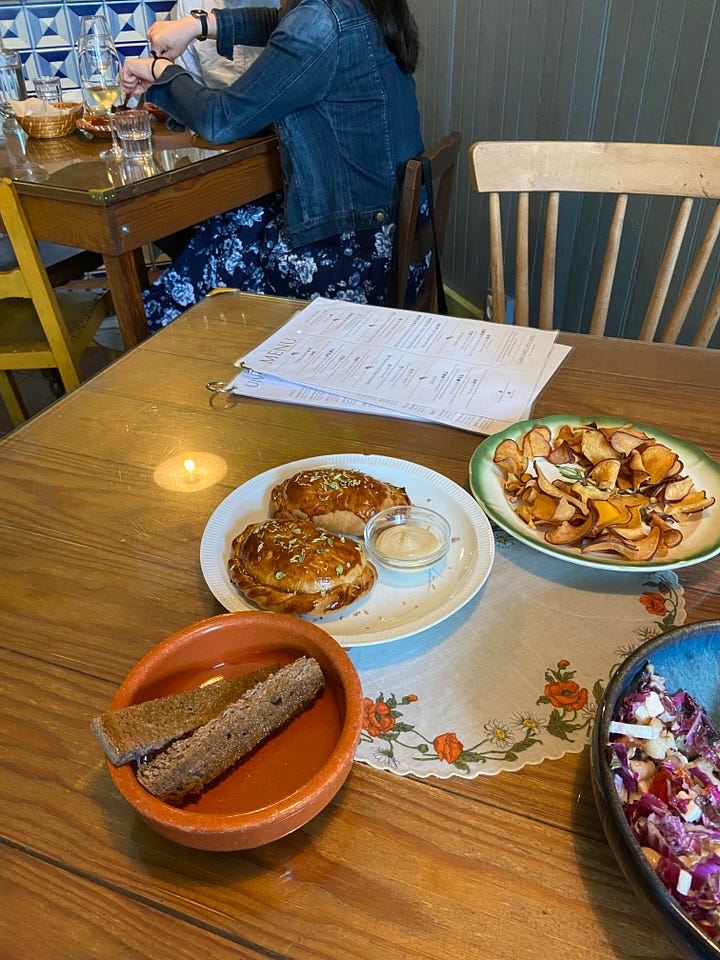
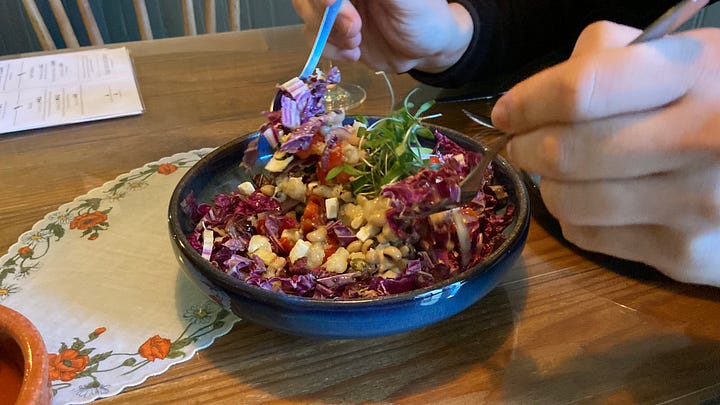
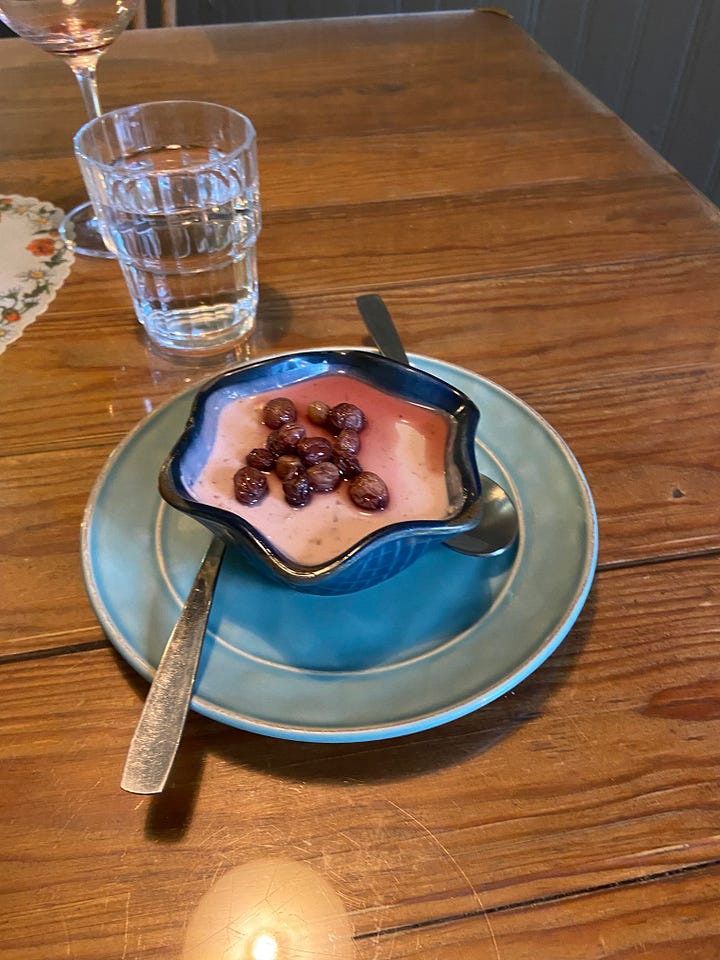

If you’re ever in Porto, make a reservation. Go to this restaurant. Have your life permanently altered by this menu.
This post is too long for email, which should tell you a lot about how much I loved my time in Galicia and Porto.
Saludos to some GOOD EATS and getting tf out of the culinary scene in Seville!




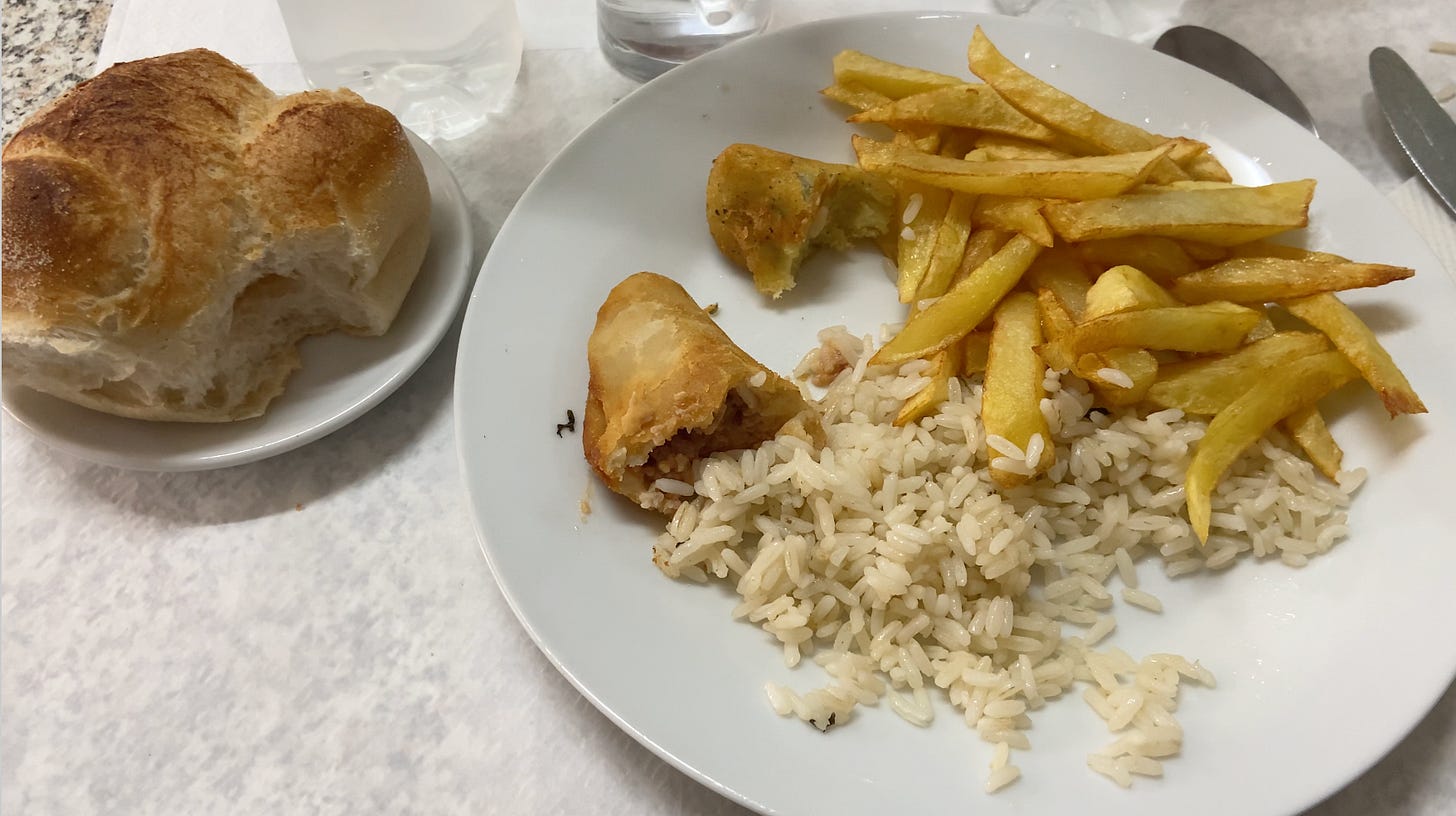
wowww all of this looks so yummy
this makes me want to go to Porto solely to visit this restaurant 2 or 3 times